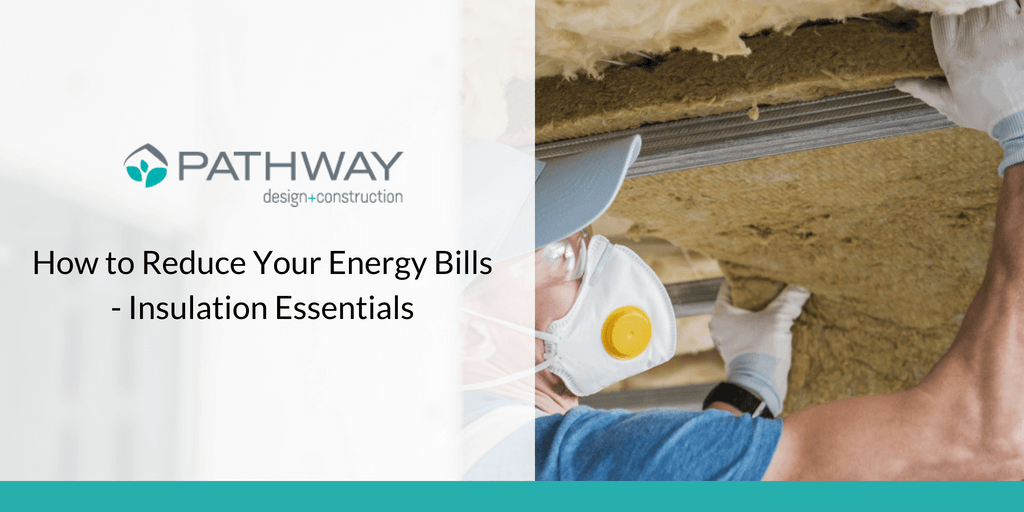INSULATION ESSENTIALS AND # 1 MATERIAL WORTH THE INVESTMENT
How much of your home’s energy bill is wasted?Just take a guess.
Did you guess anywhere between 40%-60%? According to the US Department of Energy about half of a home’s energy is wasted when it is under-insulated and improperly air-sealed.
HOW TO REDUCE YOUR ENERGY BILLS
Insulating your home provides resistance to heat flow (including heat escape) and your heating and cooling costs could be reduced by at least $500 per year.
Do you know how well your home is insulated? If at all?
THE LOWDOWN ON INSULATION
To help put the value or benefit of insulating your home into perspective, it is important to understand how insulation actually works.
Insulation works by providing resistance to heat flow, which involves three basic mechanisms:
- Conduction: this is the way that heat moves through materials, similar to when a spoon is placed in a hot cup of coffee.
- Convection*: this is the way heat circulates through liquids and gases. Warmer air rises toward the ceilings, and cooler, denser air sinks toward the floors in your home.
- Radiation*: also known as radiant heat. Radiant heat travels in a straight line and heats anything solid in its path that absorbs its energy.
* Most common insulation materials that work by simply slowing conductive heat flow.
Regardless of the mechanism, heat flows from warmer to cooler until there is no longer a temperature difference.
For example, in your home, heat flows directly from all heated living spaces to adjacent unheated attics, garages, basements, and even to the outdoors. This might explain why it is always cooler downstairs.
Heat flow can also move indirectly through interior ceilings, walls, and floors–wherever there is a difference in temperature.
HOW DO YOU KNOW IF YOUR HOME HAS ENOUGH INSULATION?
According to the International Energy Conservation Codes (IECC) most homes that are 10-years or older do not have enough insulation.
It is true that your remodeler’s job is to give you what you want while complying with the building codes. However, when it comes to insulation, your remodeler is only required to address the insulation on walls, ceilings, and floors that are opened up.
WHAT DOES THAT MEAN?
That means that if only half of your home’s walls have the sheetrock removed, then only half of your home’s insulation is fixed.
WHAT ARE YOUR BEST OPTIONS WHEN IT COMES TO INSULATION WHEN YOU START A REMODELING PROJECT?
There are many types of insulation on the market right now, and in order to choose the best type of insulation, you should first determine the following:
- Where you want or need to install/add insulation
- The recommended R-values for areas you want to insulate
‘An insulating material’s resistance to conductive heat flow is measured or rated in terms of its thermal resistance or R-value — the higher the R-value, the greater the insulating effectiveness. – energy.gov



Other aspects you may want to consider:
- Potential energy savings
- Air quality impacts
- Lifecycle costs
- Recycled content
- Ease of installation
- Upfront costs, if any
- Government Incentives
- What areas of a home are important to upgrade?
The tip you were looking for…
Whether you are upgrading your attic, garage or the whole house, it is important and worth investing in not only the right type of insulation for your home BUT in the material for your insulation as well.
THE TYPE OF INSULATION
First, ask yourself, is your home properly air sealed? Since insulation plays a huge role (and while there are many different types of insulation), spray foam is one of the only reliable air sealing solutions available as it stops all 3 types of heat transfer. It allows you to seal common air leak areas like electric outlets, windows, doors, HVAC ducts, framing connections, etc. You can explore other types here.
THE MATERIAL
You can use spray foam but consider filling in the rest of the area (or even use instead) with a material called rock wool.
Why?
- It is a man-made material consisting of natural minerals like basalt or diabase
- Contains an average of 75% post-industrial recycled content.
- It doesn’t require additional chemicals to make it fire resistant, and it is commonly available as blanket (batts and rolls) and loose-fill insulation.
- Mineral wool batts have a higher R-value
- Mineral wool batts are easier to install. Mineral wool has form i.e. if you pick it up it does not drape or fold; it retains its shape and can be cut precisely to fill every void — so no gaps, no sags, no spaces.
- Mineral wool only comes in unfaced batts (no foil or kraft paper vapor retarders are offered) meaning that an independent vapor retarder must be installed. Simply said, this is the best way to create an airtight envelope for a house.
- Mineral wool is hydrophobic and does not stay wet. In fact, water beads up and rolls off the surface of mineral wool.
For additional material options click here.
WHAT’S NEXT?
If you want to have a healthy indoor environment that is comfortable and saves you money on utilities, then start with properly insulating your home.
Recap:
- Determine the area of the home that needs your attention. Attic? Garage? Other?
- Measure the R-value of your current insulation
- Select the type of insulation you want to install e.g. blanket: batts and rolls, foam etc.?
Your remodel professional or builder should guide you on the important factors you will need to consider in relation to your remodel. Sources:
https://www.energy.gov/energysaver/weatherize/insulation
https://www.energy.gov/energysaver/articles/how-much-can-you-really-save-energy-efficient-improvements
https://www.energy.gov/public-services/homes/home-weatherization/insulation
http://www.greenbuildingadvisor.com/blogs/dept/guest-blogs/mineral-wool-insulation-isn-t-fiberglass
http://www.greenbuildingadvisor.com/green-basics/green-enclosures-do-four-things


